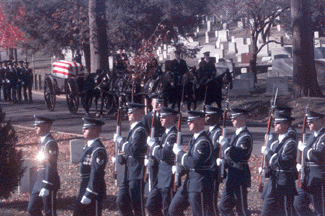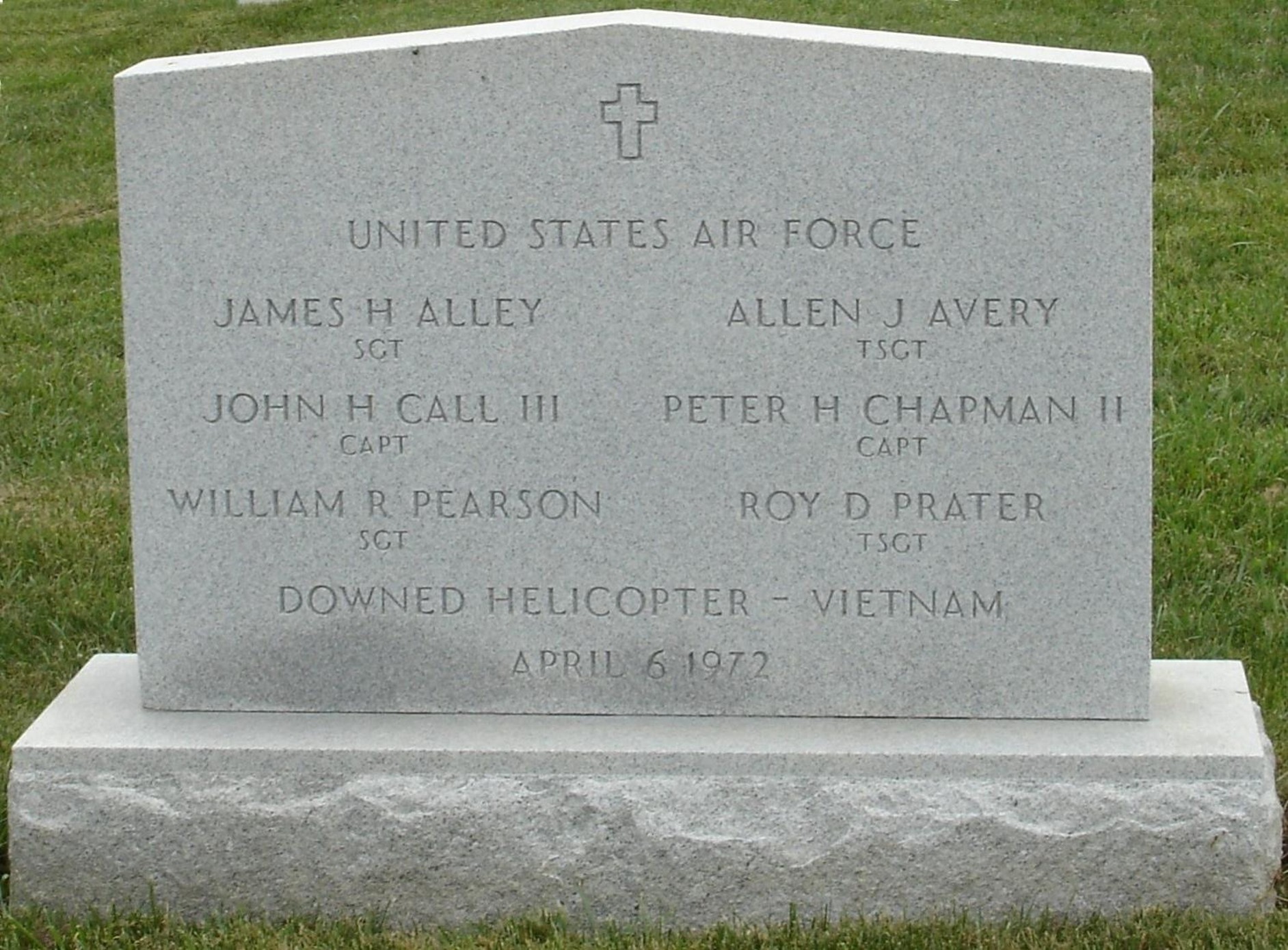These young Americans were killed in the crash of their helicopter on April 6, 1972 while on a rescue mission in Quang Tri, South Vietnam (see story below).
Their bodies were subsequently recovered and identified in 1997 and they were laid to rest with full military honors, including a helicopter flyover, at Arlington National Cemetery.
Welcome home and rest in peace.
Allen Jones Avery
Tech Sergeant, United States Air Force
Born at Auburn, Massachusetts, February 22, 1943.
James Harold Alley
Sergeant, United States Air Force
Born at Plantation, Forida, September 18, 1949.
John Henry Call III
Captain, United States Air Force
Born at Potomac, Maryland, February 2, 1947.
Peter Hayden Chapman II
Captain, United States Air Force
Born at Centerburg, Ohio, August 26, 1940.
William Roy Pearson
Sergeant, United States Air Force
Born at Warner, New Hampshire, April 18, 1951.
Roy Dewitt Prater
Tech Sergeant, United States Air Force
Born at Tiffin, Ohio, July 1, 1936.
Thanks to Keith Barnes of Arlington National Cemetery for providing some of this information and for helping us to remember these brave young Americans.
Rest in Peace
Forever Young
Courtesy of
United States Air Force Press Service
Twenty-five years after the longest search-and-rescue mission in Air Force history, two pararescuemen, a mechanic, photographer, pilot and co-pilot, were remembered November 19, 1997 for giving their lives trying to save others.
Six crewmen from Jolly Green 67, Captains John Call III and Peter Chapman II, Technical Sergeants Allen J. Avery, James Alley and Roy D. Prater, and Sergeant William R. Pearson, were honored at Arlington National Cemetery. Their remains were recently returned home from their fatal attempt to rescue a downed navigator in Vietnam; their helicopter crashed after being hit by enemy fire.
The object of their rescue attempt was Lieutenant Colonel Iceal Hambleton, whose call sign was Bat-21. He was flying aboard an EB-66 leading a B-52 bomber strike when his aircraft was struck by a surface-to-air missile. The only one to eject safely, Hambleton landed near a highway junction on a Communist supply route.
Intelligence sources reported 30,000 enemy troops in the area. On the fourth day of search-and-rescue operations, Jolly Green 67 went down. All aboard were lost.
Air Force, Army and Navy teams continued fighting for the next seven days to retrieve Hambleton before he was saved.
A quarter century later, the funeral service for the Jolly Green 67 crew began with a fly-over by two MH-53J Pave Low III helicopters from Hurlburt Field, Florida. The Air Force Honor Guard and Air Force Band from Bolling Air Force Base, Washington, D.C., also helped commemorate the event.
Among the mass of people at Arlington paying respects to the helicopter crew were red beret-wearing pararescuemen who honored their fallen comrades. The veterans also represented pararescuers who served in Southeast Asia and rescued more than 3,800 servicemembers during the war.
Among those who could not attend the funeral was Bat-21 himself; however, the 78-year-old Hambleton wrote about how much he appreciated the sacrifice of the Jolly Green 67 crew. Dan Manion, one of many pararescuemen who helped search for Hambleton, read the letter.
“This is a crew of real heroes,” Manion said. “They were doing what they had been trained to do. They deserve all the accolades that we, the living, can bestow upon them. Again, I thank them, I honor them, and I will always hold great faith in my heart with them.”
Colonel Mark Clark was a first lieutenant at the time of the Bat-21 search, and was the first to go in trying to extract Hambleton. But Clark's OV-10 was shot down, and he became part of the Bat-21 rescue. He, too, was saved. He attended the Arlington ceremony and addressed the Jolly Green 67 family members.
“Each of you played a distinct role and forming the character of these men who so willingly paid a very dear price to help me get out of the jungles of Vietnam,” he said. “You have my deepest sympathy — you and these six brave men.”
The United States Air Force Honor Guard Escorts The Six Young Men To Their Final Resting Place In Arlington National Cemetery.
Six Vietnam War Airmen Buried
By Mike Householder Associated Press Writer Thursday, November 20, 1997; 8:30 a.m. EST
WASHINGTON (AP) — With a helicopter flyby, the sounds of an Air Force band and Arlington National Cemetery as a backdrop, six airmen whose remains were missing in Vietnam have finally been honored.
More than 100 people turned out Wednesday for the service for the six, missing in action for 25 years. They were part of a rescue attempt that was recounted in the 1988 movie “Bat 21,” starring Gene Hackman and Danny Glover.
Lt. John Call, Potomac, Md.; Capt. Peter Chapman, Centerburg, Ohio; Sgt. James Alley, Plantation, Fla.; Sgt. Allen Avery, Auburn, Mass.; Sgt. Roy Prater, Tiffin, Ohio; and Sgt. William Pearson, Webster, N.H., were on a search-and-rescue operation aboard a Sikorsky HH-53 helicopter, named the “Jolly Green 67,” near Dong Ha, South Vietnam, on April 6, 1972. The crew was trying to rescue two downed airmen when the helicopter was shot down.
The airmen the crew was trying to rescue were later found alive.
One of the men saved in the operation, retired Lt. Col. Iceal “`Gene” Hambleton, sent a letter to be read at the service.
“It was the most terrible day I had ever lived,” Hambleton wrote. “I had to stand by and watch six young men die trying to save my life. Heroes, you bet they were.”
The other downed airman, retired Col. Mark Clark, who attended the service, echoed Hambleton's sentiments about those who died.
“Have no doubt,” Clark said.”`Those men were heroes.”
Michael Robert Patterson was born in Arlington and is the son of a former officer of the US Army. So it was no wonder that sooner or later his interests drew him to American history and especially to American military history. Many of his articles can be found on renowned portals like the New York Times, Washingtonpost or Wikipedia.
Reviewed by: Michael Howard







